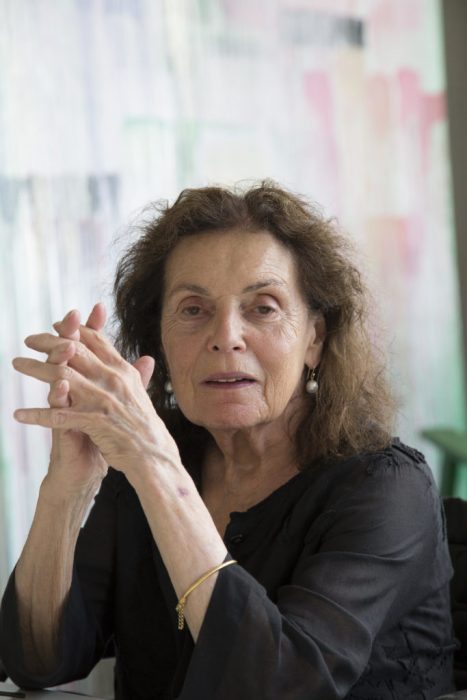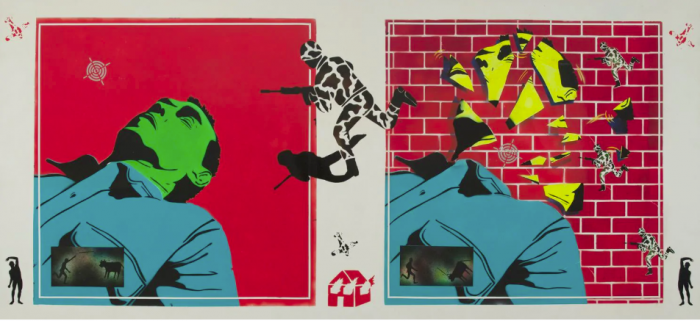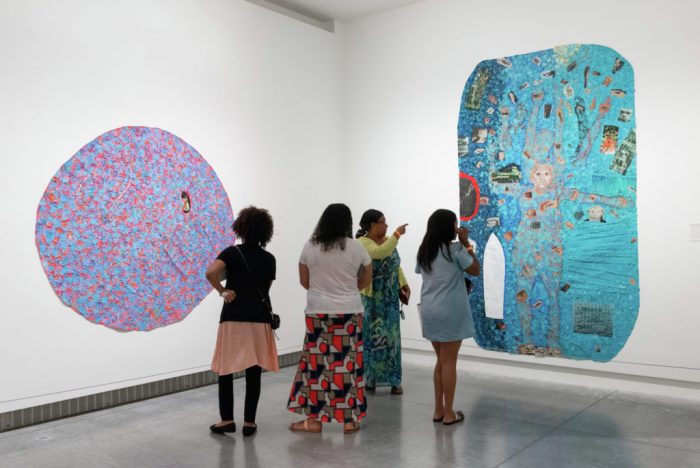ICYMI: Highlights from the week that was Sept. 16 – Sept. 22, 2018
No one can keep up with everything, so let us do it for you. We’ll gather the top Smithsonian stories from across the country and around the world each week so you’ll never be at a loss for conversation around the water cooler.
This week we have questions. Questions that need answering. Questions about old hats and wombats.

Pat Steir Will Make Monumental Waterfall Paintings for Both the Barnes and the Hirshhorn in 2019
The commissions are the latest coup for the 78-year old artist, whose career is on a hot streak.
ArtNet News, September 17

Pat Steir in her studio. Photo by Jean-François Jaussaud. Courtesy Lévy Gorvy.
Artist Pat Steir has a big year ahead in 2019.
In January, the Barnes Museum in Philadelphia will unveil “Silent Secret Waterfalls: The Barnes Series,” a monumental commission for the museum’s Annenberg Court entrance, where it hosts events. And in October, the Hirshhorn Museum and Sculpture Garden in Washington, D.C. will present her largest site-specific commission to date: 28 new paintings that will span nearly 400 feet around the museum’s inner-circle gallery.
“I’m happy to be busy always, and thrilled to take this on,” Steir told artnet News in a phone interview. “It’s nice to have it so clearly framed what I have to do for the next year.” Read more from Eileen Kinsella for ArtNet News.
Adam Rippon’s Olympic Costume and Skates Headed to the Smithsonian
They will soon be on display at the American History Museum.
Logo, September 18

Adam Rippon has donated his Olympic costume and skates to the Smithsonian Institution’s National Museum of American History.
The figure skater, who won the Bronze at this year’s Games in South Korea, making him the first out gay U.S. male athlete to medal in a Winter Olympics, shared the news on Twitter.
“Pretty cool to soon have something on display in the American History Museum. Now, I just need to convince someone that they need to be next to the ruby slippers,” he wrote. Read more from Jeff Taylor for Logo.
This low-maintenance garden shows you don’t need flowers to shine
The Washington Post, September 18

A foundation bed is planted for foliage colors and textures near the Smithsonian Castle on the Mall. (Photo by Adrian higgins / The Washington Post)
Foundation beds serve to hide the ankles of a building, but as decorative gardens in their own right, they tend to fall flat in several key areas.
They are typically too narrow, making it hard to install enough plants to create drama. They are too passive and overly reliant on evergreens. And they too often clash with the color of the structure rather than play to it.
All these pitfalls are avoided in an exemplary display I came across the other day in a space that everyone can enjoy.
The garden is a study in foliage display and color harmonies, in maroons, blues and silver, which play off the brownstone behind it. This particular border needs to be good because it fronts what is probably the most famous brownstone in America, namely the Smithsonian Castle on the Mall. Read more from Adrian Higgins for The Washington Post.
Creating Virtual Museum Experiences
Intel and The Smithsonian partner up with Sansar to bring everyone the ephemeral art of Burning Man.
Tech Trends, September 18

Linden Lab’s Sansar just announced a partnership with Intel and the Smithsonian American Art Museum (SAAM) to provide virtual access to the museum’s Renwick Gallery collections as well as its research, and education resources
“With Sansar, we hope not only to make the museum experience more accessible, but to also let people curate their own experiences and share their unique perspectives with the world,” says Jason Gholston, Head of Sansar Studios, which last year launched similar initiatives such as the Art of Star Wars exhibit to help expand the reach of unique and exclusive art collections.
The Smithsonian’s goal in doing this is to expand the reach of the Institution’s collections to a billion people, in five years’ time. This means making its museums’ objects available to the public across a wider range of mediums including immersive domains. Read more from Alice Bonasio for Tech Trends.
The Smithsonian censored him in 2010. Now, the Whitney is celebrating his grandeur.
The Washington Post, September 18

David Wojnarowicz, “Untitled (Green Head),” 1982. (Collection of Hal Bromm and Doneley Merls/Estate of David Wojnarowicz and PPOW Gallery)
Most artists are remembered piecemeal, some of their works more beloved and better known than others, and much of their production inevitably forgotten, suppressed or neglected. David Wojnarowicz, an artist who worked across multiple media and whose career was fast rising when he died of AIDS in 1992, has been remembered not just piecemeal, but for a tiny number of images and film excerpts that all seem to reinforce a caricature of his sensibility: an artist who was angry, sexually provocative and countercultural. Read more from Phillip Kennicott for The Washington Post.
Netflix Partners With Inaugural Smithsonian African American Film Festival
Variety, September 18

CREDIT: QUINCY JONES ARCHIVE
The Smithsonian’s National Museum of African American History and Culture announced on Tuesday that it will partner with Netflix in preparation for its inaugural Smithsonian African American Film Festival this October. As part of the partnership, Netflix will also screen its upcoming documentary “Quincy” at the fest.
“The museum is pleased to collaborate with Netflix in order to explore important moments in the history of America through the African American lens,” said founding director Lonnie G. Bunch III. “We are pleased the first production of Netflix is a film that honors Quincy Jones, whose creativity and commitment to racial justice is an example of the best of America.” Read more from Nate Nickolai for Variety.
African American Artists Are More Visible Than Ever. So Why Are Museums Giving Them Short Shrift?
Our research finds that less than three percent of museum acquisitions over the past decade have been of work by African American artists.
ArtNet News, September 20

Photo: David Stover © Virginia Museum of Fine Arts. Vistors to the exhibition: Howardena Pindell: What Remains To Be Seen,August 25, 2018 – November 25, 2018, Evans Court 21st Century Gallery.
This story is a collaboration between artnet News and In Other Words.
As a child growing up in Alabama in the 1950s and ‘60s, Jack Whitten was not permitted inside his segregated local museum in Birmingham. Now, the late artist is the subject of a major exhibition at the Met Breuer in New York. Its title, aptly, is “Odyssey: Jack Whitten Sculpture 1963–2017” (on view through December 2).
As recently as 1992, a proposed tour of the Whitney Museum of American Art’s Jean-Michel Basquiat retrospective was canceled when no other museums came forward to take it. Last spring, one of Basquiat’s paintings sold for $110.5 million, becoming the most expensive work by an American artist ever sold at auction.
Such landmark moments make it easy to assume that there has been a fundamental shift in the way the work of African American artists is valued. But since 2008, just 2.4 percent of all acquisitions and gifts and 7.6 percent of all exhibitions at 30 prominent American museums have been of work by African American artists, according to a joint investigation by In Other Words and artnet News. Read more from Julia Halpoerin and Charlotte Burns for artnet News.
A Marsupial Mystery: Why Doesn’t The National Zoo Have A Wombat?
WAMU, September 20
The National Zoo has nearly 400 different species of animals. But what do you do if the animal you love most isn’t one of them?
That was the dilemma facing Sylvia Gimenez, a D.C. communications professional with a passion for wombats. She decided to submit a question to our What’s With Washington series, in which we turn ideas from listeners into reporting assignments.
“Why does the National Zoo not have a wombat?” she asked. It was a strange and specific enough question that I felt compelled to spend countless work hours searching out the answer for her. How does the National Zoo make its decisions about which animals are in, and which are out? Read more from Mikaela Lefrak for WAMU.
Old hat — but maybe not Lincoln’s old hat
Chicago Sun-Times, September 20

The purported-but-maybe-not hat once owned (possibly) by Abraham Lincoln is shown at the Abraham Lincoln Presidential Library and Museum back in 2012, when the Chicago Sun-Times first raised questions about its lineage. | Rich Hein/Sun-Times
Maybe it’s just a hat.
That’s one takeaway from two investigations — one done with cloak-and-dagger-like secrecy — into the scuffed, slightly crumpled hat that its Springfield guardians have long insisted belonged to Abraham Lincoln.
The stovepipe hat is the big draw — valued at $6.5 million — at the Abraham Lincoln Presidential Library and Museum, but the investigations suggest there’s little evidence to connect it to the nation’s 16th president, according to a WBEZ radio story out this week.
For now, the hat is not on display — though it hasn’t been for months, a museum spokesman said.
“It is delicate, and too much exposure to light and fluctuations in heat and humidity can damage it, so we don’t often have it out in public,” Chris Wills, communications director, said in an email to the Chicago Sun-Times. He added that there are no plans to display it again “until we finish our new round of research and can decide the most accurate way to present it to visitors.” Read more from Stefan Esposito for the Chicago Sun-Times.
This fossil is one of the world’s earliest animals, according to fat molecules preserved for a half-billion years
Science, September 20

Dickinsonia lived in the oceans more than 540 million years ago. ILYA BOBROVSKIY/AUSTRALIAN NATIONAL UNIVERSITY
For more than 70 years, scientists have puzzled over the bewildering shapes of half-a-billion-year-old fossils that don’t look like any other organisms that have ever lived on Earth. Paleontologists haven’t even been able to tell whether many of these oddly shaped fossils from ancient oceans represent plants, animals, or some other life form. Now, traces of cholesterol—a signature of animal life—from a set of incredibly well-preserved fossils confirm that a creature called Dickinsonia, which looks a bit like a quilted bath mat, was in fact a strange animal.
These chemical traces “are giving us a completely different way of understanding what is happening” in very ancient ecosystems, says paleontologist Douglas Erwin of the Smithsonian Institution’s National Museum of Natural History in Washington, D.C. Read more from Gretchen Vogel for Science.
Critican poca diversidad en Smithsonian
Institución reitera su compromiso por representar a la población de manera justa en su equipo de trabajo y exhibiciones.
Washington Hispanic,September 21

El Smithsonian es una organización de investigación científica y cultural con sede en la ciudad de Washington, conocida también por sus museos gratuitos en la Explanada de la ciudad. Foto: Cortesía.
La escasez de latinos en la fuerza laboral y las posiciones de liderazgo dentro del Smithsonian fue puesta bajo la lupa esta semana cuando el Centro de Investigación de Estudios Chicanos y la Iniciativa Latina de Normas y Políticas de la Universidad de California en Los Angeles (UCLA), publicó un análisis que resalta el poco avance que ha habido en esta organización de investigación científica y cultural durante los últimos 24 años.
Un estudio independiente elaborado a petición del propio Smithsonian en 1994 determinó que esta institución mostraba “un patrón de negligencia voluntaria hacia los aproximadamente 25 millones de latinos en los Estados Unidos”. Según el análisis de UCLA, bajo el nombre “Invisible No More” ( Invisibles No Más), la situación no ha variado significativamente.
“Ha habido un patrón consistente de exclusión de latinos”, dijo Chon Noriega, director del Centro de Investigación de Estudios Chicanos y co-autor del análisis que evalúa el progreso de Smithsonian sobre la base de las 10 recomendaciones que sugiere el estudio de 1994, llamado “Willful Neglect” (Negligencia Voluntaria). Mas de Jossmar Castillo por Washington Hispanic.
Posted: 25 September 2018






